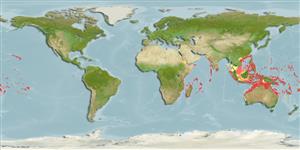กลุ่มปลาที่มีครีบคู่ แผ่แบนออกได้ลักษณะคล้ายพัด >
Perciformes (Perch-likes) >
Acanthuridae (Surgeonfishes, tangs, unicornfishes) > Nasinae
Etymology: Naso: Latin, nasus = nose (Ref. 45335).
ภาวะแวดล้อม / สภาพภูมิอากาศ / พิสัย
นิเวศวิทยา
; เกี่ยวกับทะเล,น้ำเค็ม; กร่อย เกี่ยวกับหินโสโครก; ระดับความลึก 6 - 150 m (Ref. 30573), usually 10 - 137 m (Ref. 27115). Tropical; 25°C - 28°C (Ref. 27115), preferred ?; 24°N - 32°S, 30°E - 145°W (Ref. 57251)
Indo-Pacific: Red Sea and East Africa (Ref. 9710), including the Mascarene Islands (Ref. 37792) to the Hawaiian, Marquesas and Ducie islands, north to southern Japan, south to Lord Howe Island.
Length at first maturity / ขนาด / น้ำหนัก / Age
Maturity: Lm 45.0 range ? - ? cm
Max length : 75.0 cm FL เพศผู้/กระเทย; (Ref. 1602); common length : 50.0 cm TL เพศผู้/กระเทย; (Ref. 30573)
เงี่ยงครีบหลัง (รวม): 6; ก้านครีบอ่อนที่หาง (รวม): 27-29; เงี่ยงครีบก้น 2; ก้านครีบอ่อนที่ก้น: 27 - 30. Almost fusiform, body grayish to greenish brown, paler below. Two weak immovable bucklers on each side of caudal peduncle. Without horn; short groove in front of eye. Yellowish brown preopercular margin. Over 25 cm with black tongue. Skin granulated or velvety. Teeth small and slender, close-set and pointed. Caudal fin emarginate in young.
Inhabits clear lagoon and seaward reef slopes (Ref. 9710, 48637). Benthopelagic (Ref. 58302). Usually seen in large schools (Ref. 90102). Mainly diurnal, it feeds on zooplankton such as crab larvae, arrow worms, pelagic tunicates, and occasionally filamentous red algae. The species is never poisonous (Ref. 4795).
Life cycle and mating behavior
วัยเจริญพันธุ์ | การสืบพันธุ์ | การวางไข่ | เซลสืบพันธ์ของเพศเมีย(ไข่) | ความดกของไข่ | ตัวอ่อน
Spawn in pairs (Ref. 240).
Myers, R.F., 1991. Micronesian reef fishes. Second Ed. Coral Graphics, Barrigada, Guam. 298 p. (Ref. 1602)
IUCN Red List Status (Ref. 115185)
CITES (Ref. 94142)
Not Evaluated
Human uses
การประมง: การค้า; การตกปลาเป็นกีฬา: ใช่; สถานที่แสดงสัตว์และพืชน้ำ: การค้า
ข้อมูลเพิ่มเติม
อ้างอิงการเพาะเลี้ยงสัตว์น้ำประวัติการเพาะเลี้ยงสัตว์น้ำสายพันธุ์พันธุศาสตร์ความถี่ของคู่ยีนอัตราพันธุกรรมโรคการแปรรูปMass conversion
เครื่องมือ
Special reports
Download XML
แหล่งที่มาจากอินเตอร์เน็ต
